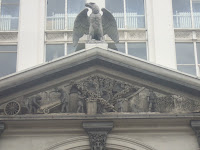Monday 2 July 2012

 Please don’t ask me whose fault it was that we missed this once an hour bus: Linda and Mary were forgiving, at any rate, so it would be churlish to suggest that the TfL bus map was at fault. With 57 minutes to fill, we had a sandwich in the cafe of the huge Crooked Billet (no relation to Penge’s as enjoyed on the 354) Sainsbury’s and, refreshed, boarded the 13.00 bus, bound for Chingford Station. We were surprised at the large Holiday Inn (views of Sainsbury’s car park, the North Circular and the A112; but people do need to stay somewhere on the way into and out of London)
Please don’t ask me whose fault it was that we missed this once an hour bus: Linda and Mary were forgiving, at any rate, so it would be churlish to suggest that the TfL bus map was at fault. With 57 minutes to fill, we had a sandwich in the cafe of the huge Crooked Billet (no relation to Penge’s as enjoyed on the 354) Sainsbury’s and, refreshed, boarded the 13.00 bus, bound for Chingford Station. We were surprised at the large Holiday Inn (views of Sainsbury’s car park, the North Circular and the A112; but people do need to stay somewhere on the way into and out of London) We came out of the supermarket area, and passed the Walthamstow Stadium. It is four years since there were any greyhound races there, and the planning row about developing the site seems to go on and on. I should have thought English Heritage would want to maintain the handsome stadium, even if it were to be converted to community use of some kind. Ian Duncan Smith, the local MP, appears to be against the development.
We came out of the supermarket area, and passed the Walthamstow Stadium. It is four years since there were any greyhound races there, and the planning row about developing the site seems to go on and on. I should have thought English Heritage would want to maintain the handsome stadium, even if it were to be converted to community use of some kind. Ian Duncan Smith, the local MP, appears to be against the development. The large terrace houses along Chingford Mount Road had lovely plasterwork details in varying paint shades, and we also passed the Chingford Boarding Kennels, unusually town-centre compared to many such establishments.
The large terrace houses along Chingford Mount Road had lovely plasterwork details in varying paint shades, and we also passed the Chingford Boarding Kennels, unusually town-centre compared to many such establishments.
The next feature was the Chingford Memorial Gardens and then we came to a couple of interestingly named pubs: the King’s Ford which (strangely for a Wetherspoon’s pub) has no explanation on the web site: which king? When did he ford, and what? Also the Artisan, which I suppose needs less explanation.
 Now we headed along Hall Lane, to travel parallel to the reservoirs and the River Lee Diversion. None of this was visible, but we recognised the grassy banks and fierce fencing and there are some pictures here. We turned right of the main road, which by now was called Waltham Way, to travel through neat residential areas. If some of the semis round here were once public housing, they have certainly been done up and beautified by their current owners.
Now we headed along Hall Lane, to travel parallel to the reservoirs and the River Lee Diversion. None of this was visible, but we recognised the grassy banks and fierce fencing and there are some pictures here. We turned right of the main road, which by now was called Waltham Way, to travel through neat residential areas. If some of the semis round here were once public housing, they have certainly been done up and beautified by their current owners.  As we approached the outskirts of Chingford, we noted Maximus Memorabilia which may have roman helmets on its fascia, but actually specialises in more recent collectables We were interested to pas a Corporation of the City of London Sign indicating that we were touching the edge of Epping Forest and also one of those wooden clad houses which are a feature of this part of Essex.
As we approached the outskirts of Chingford, we noted Maximus Memorabilia which may have roman helmets on its fascia, but actually specialises in more recent collectables We were interested to pas a Corporation of the City of London Sign indicating that we were touching the edge of Epping Forest and also one of those wooden clad houses which are a feature of this part of Essex.
Then we came to the war memorial, which is in the shape of a cross, quite unusual, we thought, though a quick look at the website of the UK National Inventory of War Memorials proves us wrong, as there are nearly 6000 with a cross shape.

And so we arrived at Chingford Station, where we have been before. The trip had taken the 25 minutes advertised on the bus stop; for quite a lot of the way we were the only passengers, so maybe once an hour is enough.
We noted a message to the local MP before heading to the railway station next door to return to our homes.
(It was here at
Chingford Bus Station, on a previous visit, that a bemused student doing a
survey asked us what we would do when we finished the project, and was a bit
shocked when I suggested lightly that we might all be dead by then)















































